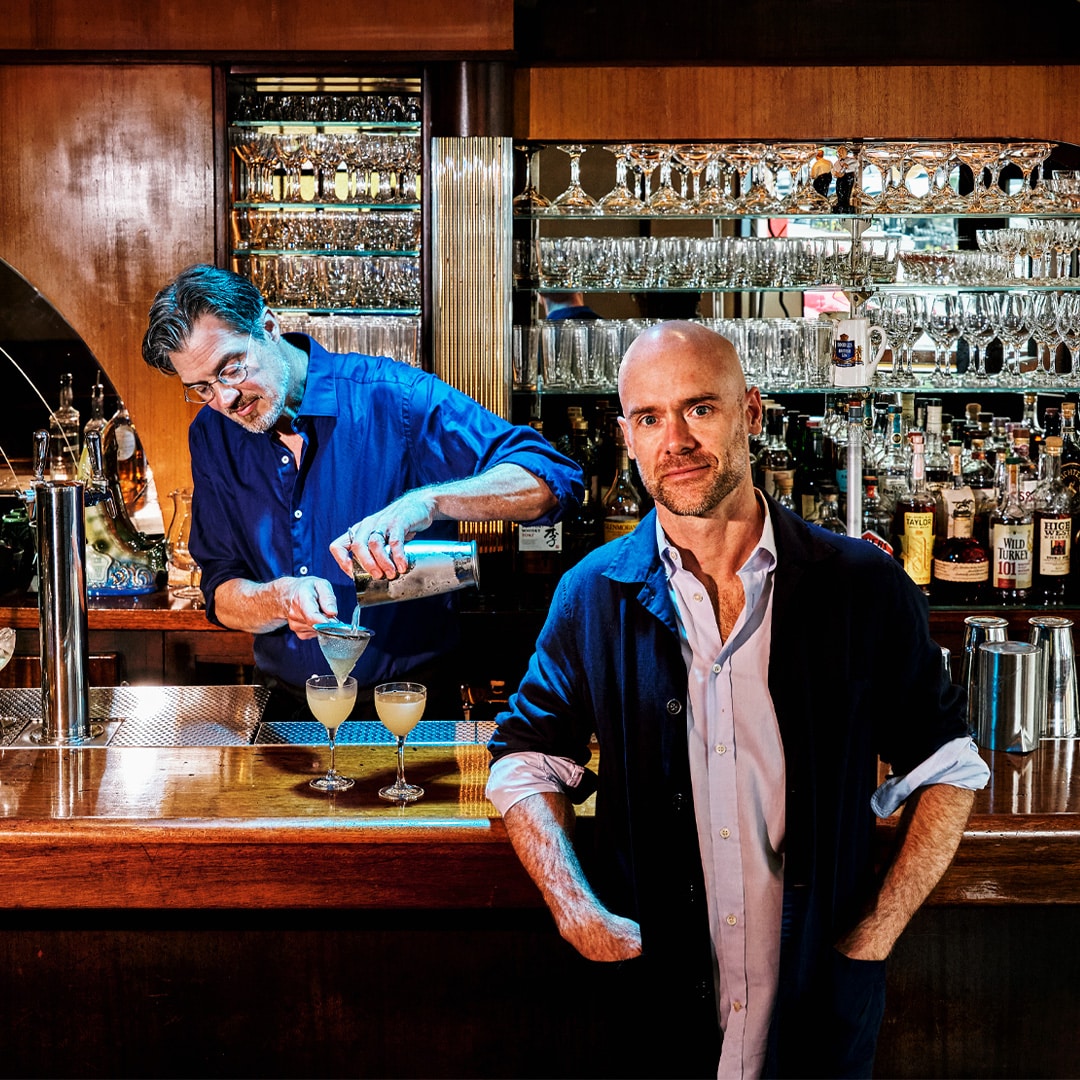If you ask a New York-based drink writer what their favorite Brooklyn bar is, odds are they’ll say, “Long Island Bar.”
The mid-century, Art Deco, red and green neon-adorned bar sits on the corner of Atlantic Avenue and Henry Street, just a few blocks from the Brooklyn waterfront. It was first opened in 1949 (or 1951 by some records) by Ramon Montero, a Spanish immigrant whose daughter Emma and her husband Buddy Sullivan took over and ran the bar for nearly 60 years with the help of Emma’s cousins, Maruja and Pepita. Then called The Long Island Restaurant, it served as a diner, bar, and hangout for a regular clientele of nearby longshoremen.
Buddy passed away in the mid-’70s and Emma and her two cousins continued to oversee the restaurant, but by the 1990s it was more of a social club for their family and Spanish friends to hang out and watch soap operas and soccer matches. One day in 2007 Emma hung the “closed” sign on the door and went on one of her regular extended vacations to Spain, but this time the bar remained closed, leaving the neighborhood wondering what would come of the historic space.
Don’t Miss A Drop
Get the latest in beer, wine, and cocktail culture sent straight to your inbox.
Bartender and writer Toby Cecchini started out at the Odeon, where he created the now modern classic cocktail, the Cosmopolitan, in 1988, and opened his own bar, Passerby, in 1999 in the Meatpacking District where he met his future business partner, Joel Tompkins. Tompkins was originally skeptical about Cecchini, assuming this funny and attentive bartender was trying to hit on his then-girlfriend and now wife, Natasha, who was a regular. But after visiting Passerby for himself, the two soon hit it off.
When Cecchini lost the lease to Passerby in 2008, he and Tompkins spent years looking at possible venues for a new bar without any luck. Like many, they had wondered about the future of The Long Island Restaurant, and through serendipitous circumstances signed the lease in 2011, restoring the room to its former glory and christening the new Long Island Bar in 2013.
The Long Island Bar is one of several notable bars turning 10 this year, but Cecchini won’t be throwing a party, or even sharing the actual anniversary date. He’s been burned before about the lifespan of a bar, but countless drinkers will surely hope The Long Island will be a part of Brooklyn for years to come.
Stir up a cold, crisp Martini and read on as Cecchni, Tompkins, former and current bartenders, and a cast of longtime regulars share their stories of The Long Island Bar.
That Bar On the Corner
Passerby closed in 2008 when the landlord executed a demolition clause in the lease. Cecchini tended bar “just for kicks” for friends from time to time, while he and Tompkins worked toward opening a bar together. Emma Sullivan permanently closed The Long Island Restaurant in 2007, leaving the ghost ship of a bar vacant with the windows covered in paper for years, and the neighborhood wondering about the future of this art-deco landmark.
Tompkins (LIB co-owner): After they closed, I went to every length we could think of to contact them. I tracked down the granddaughter and sent her a letter which she responded to and pretty much said, in the politest way possible, “everybody’s tried that already, leave me alone.” I slipped notes under the door and loitered to see if anyone ever came in or out of there. I’d fully given up.
Cecchini (LIB co-owner): I had noticed a shop across the street and every time I passed by it was closed. One day it was open and I went in and met the owner, David Alperin. As I complained about my search for a new bar he asked if I ever considered The Long Island Restaurant on the corner. I was like, “What are you talking about, dude? Everybody has tried to get that space. It’s owned by some crazy Spanish woman who lives in Spain and won’t talk to anybody.” And he was like, “Well, she’s not crazy. She’s my grandmother, actually.” I asked to talk to his grandmother, and he said, “I can’t offer an audience with her but I have the keys if you want to take a look at it.” So we walked across the street and the place looked like it had simply locked up their doors after service. The glassware was still on the shelves. Emma lived nearby and briefly poked her head in while we were there to see what was going on and the next day David called and said, “My grandmother wants to offer you the lease.”
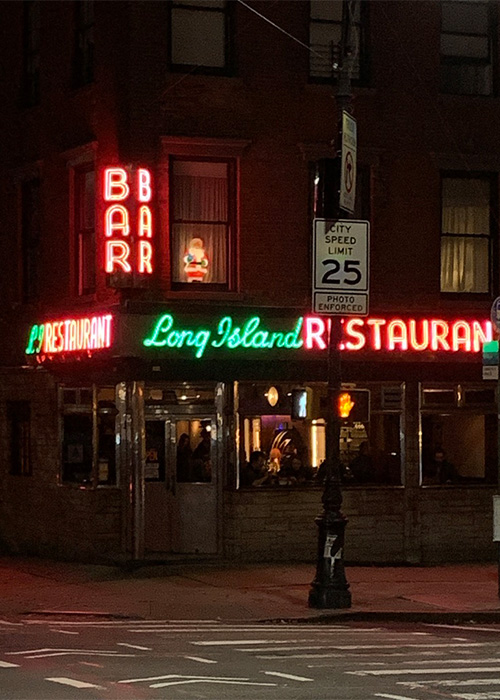
Tompkins: A part of the story that’s often left out is they had recently offered the lease to someone who had pulled out a few months before we came in. The woman who passed on it planned to gut it so thankfully that fell through.
Cecchini: It was one of those lightning-strike moments. After Passerby I thought I’d have another bar in six months and then six years later we finally found something.
Bringing the Bar Back to Life
After signing the lease in 2011, Cecchini and Tompkins spent a year and a half restoring the bar to its former glory, including the iconic neon sign on the bar’s exterior that had remained broken since the 1970s.
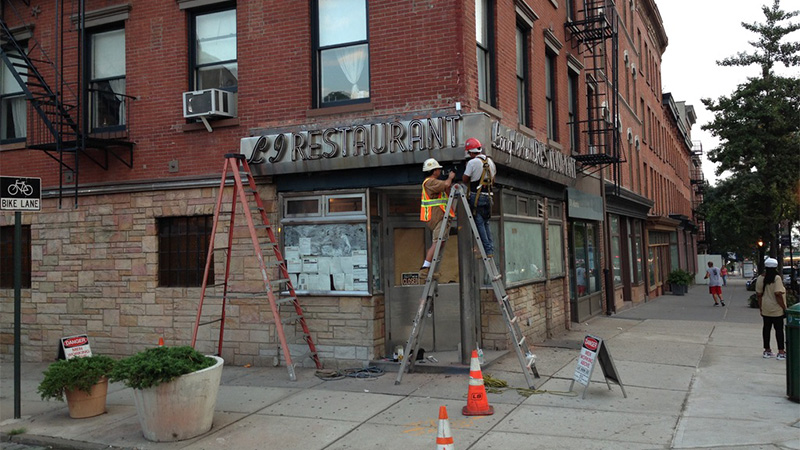
Cecchini: We were like, “Let’s just bite the bullet and spend $10,000 to make that sign glow once again,” and the bid that came back from Let There Be Neon in Manhattan was much higher than that. I choked on my tongue at their quote so they offered to throw in a little sign. That’s why we have the “NO DANCING” neon sign hanging between the bathrooms.
Tompkins: Emma had already essentially signed off on the demolition so when she walked in after we were finished and it looked like a shined-up version of the old place it brought tears to her eyes.
Andrew Stubbs Johnston (creative director, upstairs neighbor): I’ve lived over LIB for 13 years. My stepdaughter said it best when she was around 8 or 9: “You never feel alone because there is always a party downstairs.” My father raised me on a steady diet of noir films so I’m thrilled to have a splash of pink neon light across my walls at night. There is probably nothing more New York than having a neon sign outside your window.
Robert Simonson (writer and author, LIB regular): I’d say 50 percent of the allure of LIB is that beautifully preserved corner space, with its picture windows and gorgeous neon. There’s just nothing like it. It attracts the regular and the stranger like a moth. You feel great just walking through the door. It has the frisson of a classic New York moment.
Christene Barberich (writer and entrepreneur, neighborhood LIB regular): Before it actually re-opened, I would walk past the bar frequently and think of it like this sleeping beauty and hoping so much that it would become something special. And honestly, it became more special than any of us could have ever imagined.
Assembling the Team
Before opening in October 2013, Cecchini assembled an “Ocean’s 11” crew of talented bartenders for the opening team, including himself, Cabell Tomlinson, Brian Miller, Katie Stipe, Phil Ward, and Tim Miner.
Katie Stipe (LIB opening bartender): My longtime friend Cabell Tomlinson was assisting Toby with some opening procedures and she essentially brought on myself, Phil Ward, and Tim Miner. At the time I was living just down the street so it was, by far, one of the most pleasant commutes to work I experienced in my years in New York.
Phil Ward (LIB opening bartender): Aside from Toby, I’ve been here the longest. My bar, Mayhuel, was still open but that was the point I realized I’m going to get a bartending job somewhere because it’s more fun than running your own bar.
Morgan Reis (sales manager, LIB regular): Philip always leaves people dumbfounded. He has the ability to charm people without cracking a smile. But all the bartenders have high standards for hospitality, which isn’t what you’d expect from a bar scarred with cigarette butt burns and a guy like Phil who looks like he walked off a 1970s movie set.
Stipe: I think LIB has always had a bar team of mostly curmudgeons. Some of my favorite people have worked there for years; it’s like their union gig at this point. I am not sure if any other women have worked behind that bar other than myself. But I can say that it didn’t feel like a boys’ club, it was more like working with your brothers.
Tim Miner (LIB opening bartender): I went in for an interview with Toby and Joel and it went about as terribly as an interview can go, or so I thought. I bragged about having expanded the cocktail program at the Jakewalk to which Toby responded at length about how cocktails had become too precious and that he was tired of them. He then noticed on my resume that I was from Rhode Island and asked if I was a fan of coffee syrup, a regional specialty used for making coffee milk. Sensing what I took to be enthusiasm, I assured him I was and had, in fact, just included it in a cocktail on my most recent menu. He then went on to describe his intense dislike of coffee syrup. I can’t remember the quote directly but if you’ve ever spoken with Toby then you know his vocabulary is second to none, particularly when describing how terrible something is. But a day or so later he called to ask me to join the team and I was elated.
David Wondrich (writer and author, LIB regular): The bartenders are veterans who’ve done the job long enough to know things besides how to mix drinks. Things like how to talk to people, how to be gracious when gracious is needed, gruff when gruff is. Their egos don’t get bruised if you don’t order what’s on the cocktail list. They can mix anything and are happy to try.
Georgia Fulton (LIB server and creator of LIB playlists): I came on in March 2014 when they started serving food. I guess I’m the longest-serving server at LIB but that doesn’t really mean anything because at this point we’ve all been there so long.
David Moo (LIB bartender, partner at Quarter Bar): I started working at LIB in April 2014. Toby was a friend and I stopped by when he and Joel were building out the bar. There were some similarities to my bar and LIB. They’re both what I call hybrid bars. Just a beloved local joint that’s also a fully operational cocktail bar with highly trained bartenders.
KJ Williams (LIB bartender): Toby has always sounded proud when he’s trying to figure out how many collective years of bartending experience we all have. And there is a confidence in him that each individual bartender always has the best interests of the bar and the guests in mind but there’s a certain autonomy of craft. The menu drinks are consistent specs, but off-menu requests, from true dealer’s choice to specific classics, can differ slightly from bartender to bartender. It’s an honest, sometimes unspoken, admission that there is more than one way to skin a cat.
Cocktails, Cheese Curds, and Cheeseburgers
The Long Island Bar curates a tight cocktail list of originals and revised classics, including favorites like The Long Island Bar Gimlet, Boulevardier, and Delores del Rio, a spicy Margarita riff. Though, these days the top three drinks, according to Cecchini, are “The Martini, the Martini, and the Martini.” Six months after opening, LIB added food to the menu, with Corwin Kave working with opening chef Gabe Martinez to develop the signature L.I. Burger among other still-on-the-menu classics.
Wondrich: The cocktail list is short and to the point and makes a good starting place, placeholder, and guide to the perplexed, without limiting your choices.
Colleen Newvine Tebeau (marketing consultant and coach, neighborhood LIB regular): I so rarely order from the cocktail list. Part of what I love about being a regular is the bartenders know my tastes and I deeply trust them.
Victoria Stapleton (publishing marketing executive, longtime LIB regular): If you love a gin Martini (which you should), this is the place to get one. So perfectly crisp and cold, and best served the shrimp cocktail.
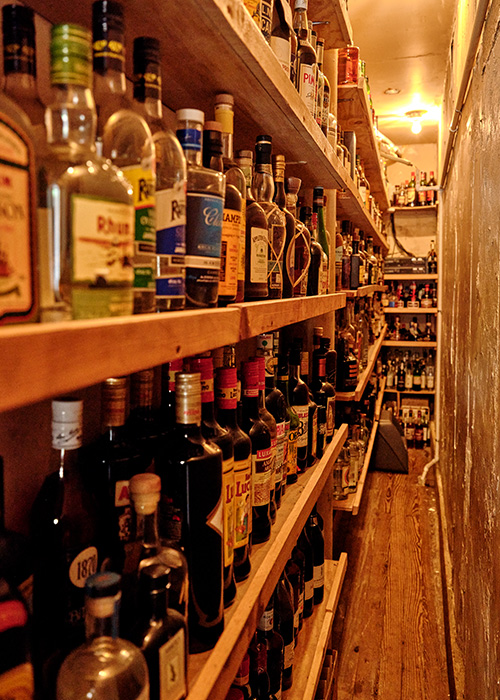
Kevin Walker Garrett (LIB chef): At LIB I work with a lean crew of industry professionals who are very good at what they do and are an absolute pleasure to be around. To watch Phil Ward create a cocktail in real time is a thing of beauty. And to walk down Atlantic Avenue toward the bar in the evening and see the neon sign illuminating that corner of the neighborhood is pure bliss. The bar is just full of special moments.
Simonson: The burger and the fried cheese curds — which are the best cheese curds in the world — are the mainstays and the only things that must never leave the menu.
Garrett: The burger, little gem salad, deviled eggs, and fried cheese curds will always remain on the menu. These dishes define the bar and the customers love them. We want to give people what they want while also rotating in new items seasonally.
Here Comes a Regular
Since opening, the bar has fostered a community of repeat guests from the neighborhood — and beyond.
Ward: I like all of my regulars for different reasons. But sometimes they try to get a little too familiar with you too fast. It’s kind of like a relationship. You have to take your time and let them get used to you before they accept you. Bartenders are like cats. You can’t just walk in and try to pick them up.
John Deragon (co-opening beverage director of PDT, LIB regular): I like to come in every Thursday. I live in Park Slope and the B63 bus leaves from right in front of my house and drops me off at the bar. I get there right when they open as they’re busier than ever these days. I like the big clock over the bar. It’s quirky and helps you gauge your evening and pace yourself if needed.
Fulton: I love the clock. It’s kind of janky and old and unreliable. But it’s beautiful and it fits that specific space on the wall perfectly, and I love the way that it lights up.
Stapleton: I have been going to LIB since the very first week. The bar is like a really good book, one that you can read over and over. The plot of a book does not change, your ideas of its meaning evolve as you evolve. LIB’s furniture does not change, but your experience being of it can develop the more time you spend there. The bar is comforting without being exactly comfortable. It is elegant without snobbery. It is unfussy without being sloppy.
What Makes Long Island Bar So Special
In a historic space with so many unique details it’s hard to pick a favorite feature or put your finger on the combined elements that come together to make LIB so beloved.
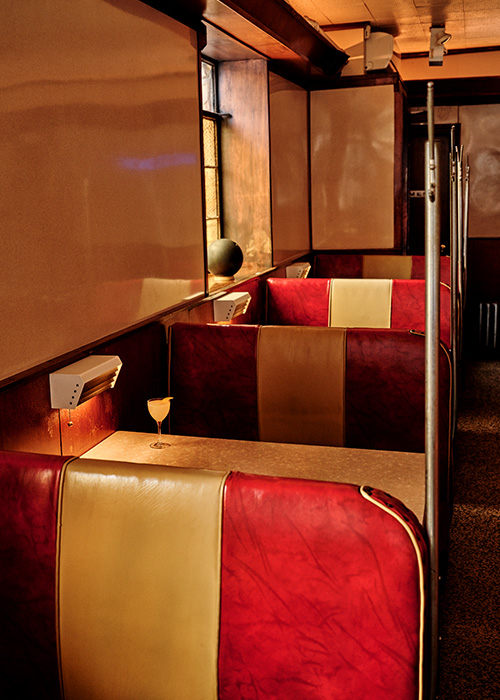
Robert Simonson: There is no one thing that makes the bar special. It’s an unlikely and improbable marriage of elements — the gorgeous Art Deco diner interior, which has a peerless saloon feng shui; the seasoned staff, which must boast the oldest median age of any cocktail bar in New York (that is a good thing, by the way); the drinks, of course, which are excellent and precisely conceived, but never precious or overwrought; the lighting and music; the choice of seating — stool, booth, table, back room, window seat — so you can tailor your perch to your mood; that you can either just drink or have a meal there, it’s perfect for either; and that the owner is often on the premises — very important to the soul of any bar.
Cecchini: The magazine rack on your way into the Lombardi Room in the back is pure Joel. He’s been changing out the magazine rack here for 10 years.
Tompkins: It came from a gag my friend Mitch does whenever he goes to someone’s place for a dinner party. He’ll hide a really esoteric magazine in their bathroom so that all the other guests think that their hosts read “Ferret Monthly” or whatever.
Amanda Schuster (writer and author, neighborhood LIB regular): The “NO DANCING” sign is the Miss Keens of LIB. However, what I really love is the bar itself, the size, the retro details, the curve near the door. It’s a beautiful thing.
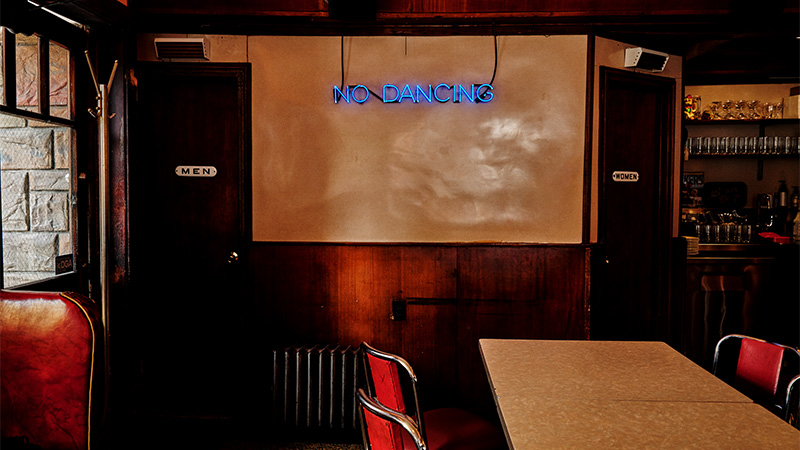
John Tebeau (author and illustrator, neighborhood LIB regular): I love all the vintage cigarette burns in the wood at the end of the bar, and that Toby and Joel didn’t sand them out but varnished right over them to preserve that history. I also dig the Julio Iglesias button and the Wisconsin muskie decanter by the cash register, and, of course, the photo of Liberace on an exercise bike..
Johnston: The reserved pink chairs at the end of the bar with plaques for Emma, Maruja, and Pepita is such a thoughtful gesture to the family history.
Ward: Gary Regan once described a good bar saying, “You should feel better when you leave than when you walked in.” If you could put your finger on what it was then everybody would do it. This is just a good place.
Wondrich: At a time when so much of Brooklyn’s past is being torn down or thrown in dumpsters, they kept a really strong link to the weird, not-fancy steel town on the river that Brooklyn was for most of the 20th century. For that I’m grateful. I’m grateful for the grownup-ness of the place; the refusal to pander or chase trends. I think — I hope — that their legacy will be like Harry’s New York Bar’s legacy: a bar’s bar and an oasis that never runs dry.
Cecchini: I’ve always been superstitious about people celebrating bar anniversaries. It’s just going to bring down the wrath of the evil demons on you. This is such a difficult business. Anything can befall you at any moment. Yeah, we’re going to be 10 this year but I’m not telling anybody when. Not even the staff. We buffed up this space and maintained it, but we didn’t create this space. This was very much a local beloved tavern for those who were here at the time. It is now reincarnated as a beloved tavern for the people who are here now.


